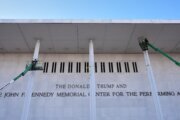TORONTO — During this past season’s observation of Hanukkah, at least a dozen synagogues and Jewish centers across Canada received the same letter — a sheet of paper bearing the depiction of a blood-soaked Star of David with a swastika in the middle. The message, written in bold black letters, was explicit: “Jews must perish.”
The incidents triggered police investigations across the country and critical declarations by Jewish leaders. But it also revealed blemishes on the social fabric of a country known for its harmony. “… this isn’t something that should upset just the Jewish community, it has to upset every Canadian because that’s not what we stand for, ” Judy Shapiro, associate executive director of the Calgary Jewish Federation, told reporters.
Canadians today find themselves grappling with issues that, from outside of the country, may appear very un-Canadian: reported hate crimes are increasing, some ethnic populations in the country increasingly are critical of how they’re treated by authorities and lawmakers are debating minority protections versus free speech rights.
“We like to hold on to the notion that Canadians value something called multiculturalism or pluralism,” says Pamela Divinsky, executive director of the Mosaic Institute, a Canadian think tank that promotes dialogue within diverse communities. “But there is growing discomfort with differences.”
To be sure, Canada is celebrated for its diversity and multiculturalism. In the 2015 Prosperity Index, put out by Legatum Institute, a London-based think tank, Canada finished first in the personal freedom category thanks to high scores in tolerance and civil liberties. Indeed, most Canadians would agree with the results of this week’s Best Countries survey results that for three consecutive years has ranked Canada as the country offering the greatest quality of life among the assessed nations.
But prominent social justice advocate Bernie Farber summed up today’s Canada by noting recently that relations between the country’s various communities “are not perfect by any stretch of the imagination.”
Statistics Canada recently reported a 3 percent increase in hate crimes from 2015 to 2016, when 1,409 such crimes were reported to police. Jews were the most targeted group (221 incidents), followed by blacks (214 incidents) and members of the LGBT community (176 incidents). While hate crimes account for less than 0.1 percent of overall crime in Canada, government statisticians suspect that two-thirds of such crimes are not reported. They add that reporting rates might vary by population; some targeted groups might be more willing to report hate crimes than others.
Months before the letters addressed to synagogues and Jewish centers were put in the mail, members of the Jewish community reported a handful of other anti-Semitic incidents in the Toronto area, including the appearance of swastikas on the walls of a university classroom and the phrase “Hitler was right!” painted on highway infrastructure.
A year ago, meanwhile, a gunman burst into a Quebec City mosque during evening prayers and opened fire. Six men were shot and killed and 19 others were wounded. The alleged shooter, identified as 27-year-old French-Canadian Alexandre Bissonnette, will stand trial on charges of first-degree murder and attempted murder.
Vigils across the country expressed support for the Muslim community, but that groundswell was soon overshadowed by heated debate over a proposal in the House of Commons to pass a non-binding motion condemning Islamophobia and religious discrimination. Opponents argue that it will limit free speech or single out Islam for special treatment in Canadian law. Thousands of Canadians signed petitions against the motion and some took part in organized protests, where they clashed with supporters of the motion. It was passed in late March.
The Muslim community, which was the target of 139 hate crimes in 2016, was at the center of controversy again last October, when Quebec lawmakers passed legislation requiring people in that province to uncover their faces when giving or receiving public service. Many Muslims see the law as an attack on women who wear the niqab.
Muslims are not the only Canadians who take issue with how they’re treated by authorities. Many members of the black community believe police discriminate against them. In March 2016, Black Lives Matters members staged a protest outside police headquarters in Toronto, spurred to action by police shootings of black men in two separate incidents. One victim was shot while wielding a hammer and the other was killed while holding a BB gun.
Three months after that protest, the organization’s members brought Toronto’s annual Pride parade to a halt by staging a sit-in on the parade route. Organizers said they were protesting “anti-blackness” by parade organizers and police. Today, blacks are the target of more reported hate crimes in Canada than any group except for Jews.
“There’s an unacceptable gap between the promises we project to the world [as a country] and the realities African-Canadians get to experience every day,” says Canadian human rights lawyer Anthony Morgan. He has written about various attacks on black Canadians, including one in which several nooses were placed in the work area of an assembly plant worker in Windsor, Ontario.
A Hard-Right History in Canada
“There has always been a ripple of hard-right activity in Canada,” says social activist Farber, who is the former CEO of the Mosaic Institute, a Canadian nonprofit organization that promotes diversity. He points to Heritage Front, a Canadian white nationalist organization founded in 1989 and disbanded 15 years later, as an example. But he says that, for the first time in recent history, Canadians who hold such views feel emboldened to act on them and to share them with others. Farber attributes that development, in large part, to Donald Trump.
“When the president of the United States makes common cause with Neo-Nazis, bigots and racists, it gives those people permission to climb out of garbage cans and pursue their hateful business,” he explains. “Unfortunately, it is no longer just street kids who are attracted to white nationalism. We now see articulate university students creating closed Facebook pages and organizing through social media.”
He notes that Bissonnette, the accused Quebec City mosque shooter, was a political science and anthropology major at a nearby university and had reportedly made online statements inspired by extreme right-wing nationalists. He “liked” Facebook pages of several politicians including Trump and far-right French politician Marine Le Pen.
Bissonnette denounced refugees in online posts, and he is not the only Canadian who has expressed antipathy toward newcomers. Last fall, ultranationalists staged a protest at a U.S.-Canada border crossing where thousands of migrants had entered the country on foot without proper documentation.
Politicians have condemned attacks against minorities and some community groups have requested more funding and resources for police forces to combat hate crimes. But that won’t fix the problem, says Divinsky of the Mosaic Institute.
“We continue to look at differences as a problem, as something that needs to be managed, controlled, contained and silenced,” says Divinsky. “But we need to shift out mindset and see differences as our best asset. Our country is great place to live. For the most part, we live pretty damn well with our differences,” she adds. “But we must improve on that.”
More from U.S. News
Denmark’s Social Policies Generally Remain a Model, Say Experts
Canadian Immigration Agencies Overwhelmed By Influx of Haitian Asylum Seekers
Canadian Classroom Program Aims to Teach Children Compassion
Canada Confronts Growing Tensions Between Its Ethnic Communities originally appeared on usnews.com







